More than a century ago, Winchester Cathedral, which is one of the largest cathedrals in Europe and the longest of all Gothic cathedrals, was saved by the heroic work of a diver, who worked tirelessly to reinforce the foundations of this historic structure, and thus preserve one of the largest and most iconic buildings in all of England.
The man was William Walker who saved Winchester Cathedral from collapsing into ruins, and by doing so he became a hero in the folklore of Winchester and for the entire country. The gratitude for him was such that there are numerous statues of him around the cathedral, and on each St Swithin's day, prayers of thanksgiving are offered to this experienced diver for the important work he had done.
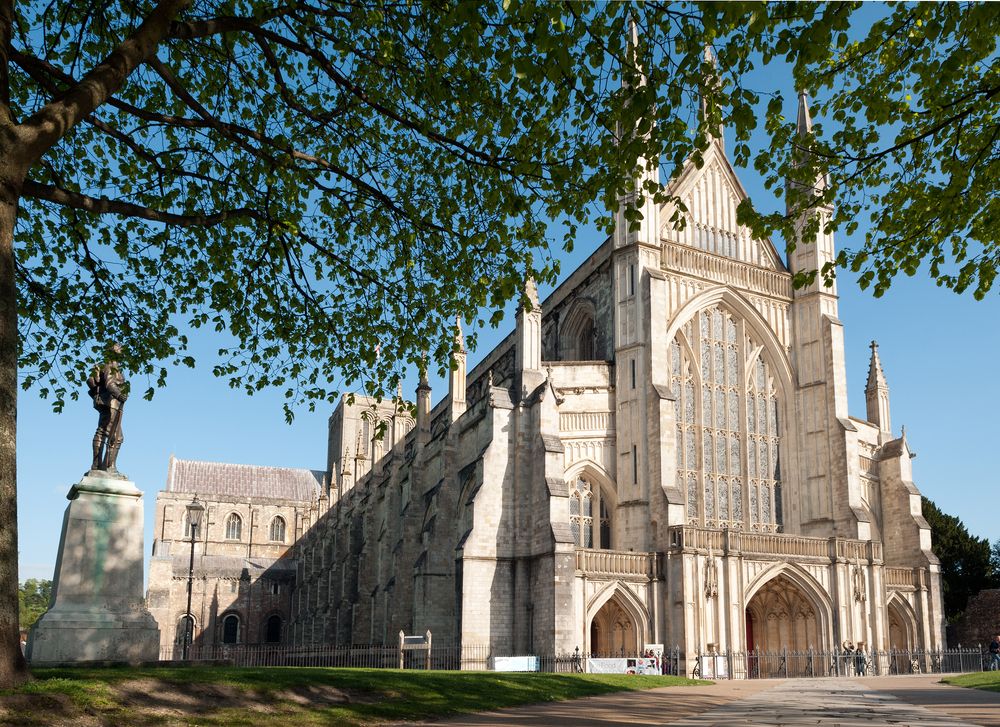
The Winchester Cathedral in Winchester, Hampshire, England. Photo: Chris Lawrence Travel / Shutterstock.com
William Walker was born William Robert Bellenie, in Newington, Surrey, in 1869. He began training as a diver at Portsmouth Dockyard in 1887, and then found work as a diver's attendant in the Royal Navy, and later as a diver's signal man. By 1892, he became a fully qualified deep-water diver. The same year, Walker left the Navy to join a diving equipment and breathing equipment manufacturer called Siebe Gorman & Company, and became their chief diver working on commercial diving and marine salvage projects.
In the early 1900s, the Cathedral Architect John B Colson submitted an alarming report that the cathedral building was in danger of collapse. Large cracks had began to appear in the Cathedral’s massive walls and vaulted ceilings, some of which were wide enough for owls to roost in. From these cracks, chunks of stone and concrete fell to the ground.
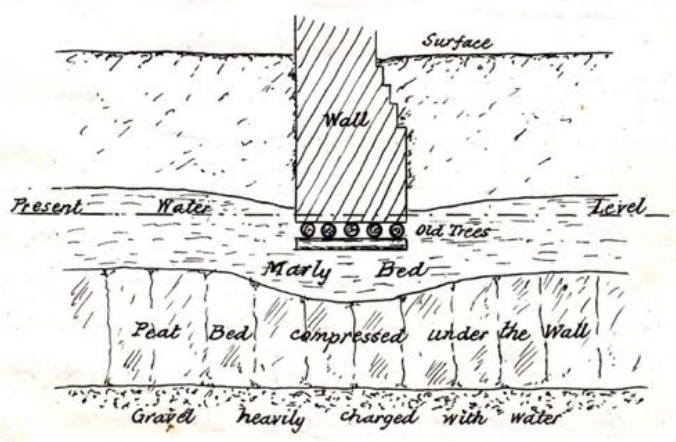
The foundation of the Winchester Cathedral before repairs. Original sketch from Fox report to the Dean and Chapter dated 23rd March 1906. © John Crook
Winchester lies in the floodplains of the River Itchen, and the Cathedral sits on peaty soil with a high underlying water table. Bishop Walkelin, the Bishop of Winchester, was probably aware of the poor soil condition but still choose Winchester as the location for his ambitious construction project because of the prestigious and historic nature of the site adjacent to the Saxon minsters. The spot was also ideally situated close to the river for a water supply, and opposite the royal palace.
The medieval builders tried to stabilize the soggy ground by laying beech logs beneath the foundations to spread the load of the massive walls. The timber for this foundation as well as the cathedral floors and ceilings came from the Forest of Hempage Wood. The story goes that when Bishop Walkelin approached King William I asking for timber for the building, the King told the bishop that he could have as much wood as he could collect in four days and nights from the forest. The bishop brought an army of carpenters and within the assigned time cut down the whole forest and carried it off to Winchester to the chagrin of the King. The bishop managed to placate the King by offering to resign from his seat of power, and the King observed that he was too liberal in his grant and the bishop was too greedy in availing himself of it.
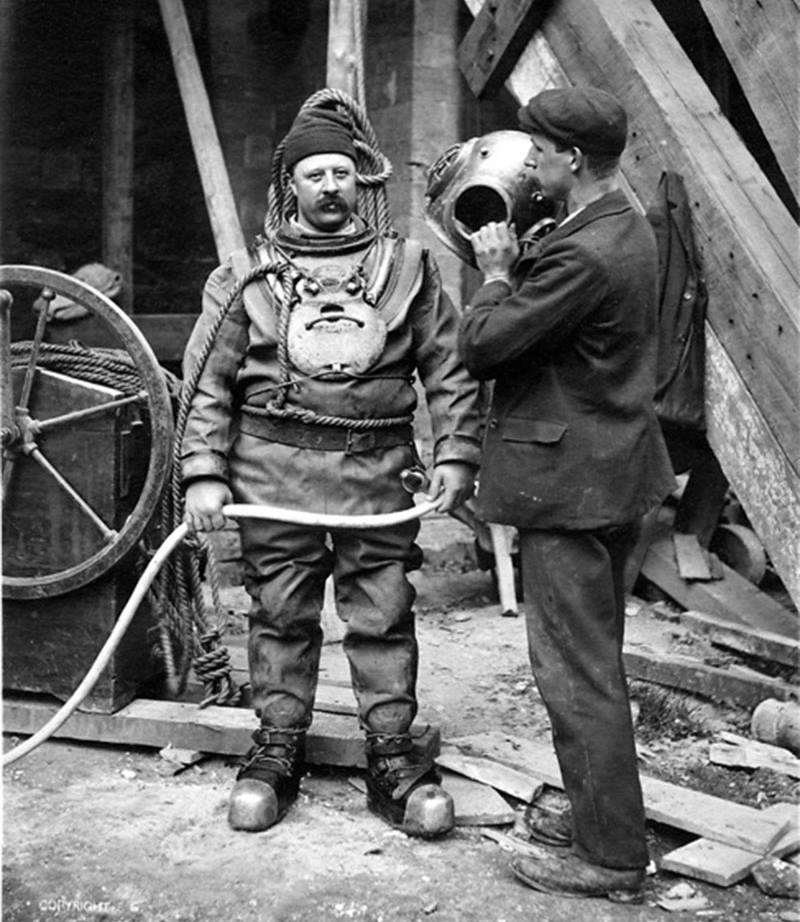
William Walker getting ready for a dive.
The layer of peat below the water table constantly troubled the builders, as it did test the ingenuity and skill of those charged with the responsibility of maintaining and caring for this great cathedral throughout the years. Over the centuries, the timber foundation began to decay and the walls began to lean outwards, endangering the cathedral.
An architect Thomas Jackson and a civil engineer named Francis Fox were swiftly brought in. Fox and Jackson's solution was to dig narrow trenches underneath the walls of the building, remove the decaying beech logs and fill them with concrete to firm up the foundations. But when workers dug below the water table, the trenches filled up with water quickly and even a steam pump couldn’t hold it back long enough. Then engineer Francis Fox had a brilliant idea. Why not use a deep-sea diver to do the work?
So William Walker was brought in.
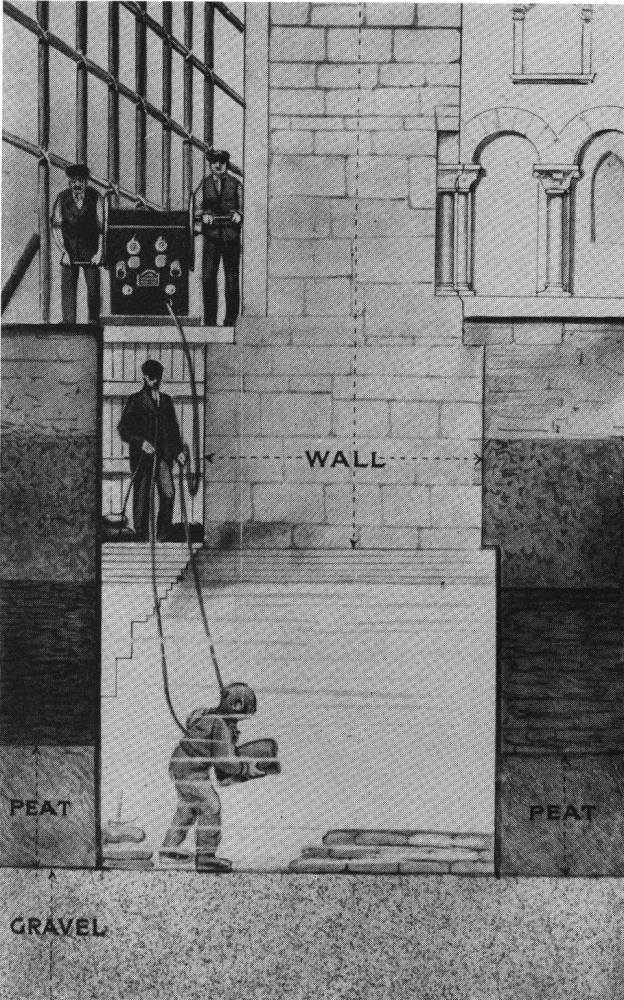
Illustration showing how William Walker worked underwater laying bags of concrete.
Between 1906 and 1911, Walker worked tirelessly, spending nearly six hours a day underwater, propping up the cathedral with 900,000 bricks, 114,900 concrete blocks and 25,800 bags of cement. He worked under total darkness because the water was too murky for light to penetrate 20 feet, the depth at which he worked. His huge, heavy diving suit (which weighed 200 pounds) took so much time to put on that whenever he took a break, he’d just take off his helmet in order to eat his lunch and smoke his pipe.
After Walker finished his work, the groundwater was safely pumped out and the concrete Walker had put into place was able to bear the foundation walls. Bricklayers were then able to restore the damaged walls.
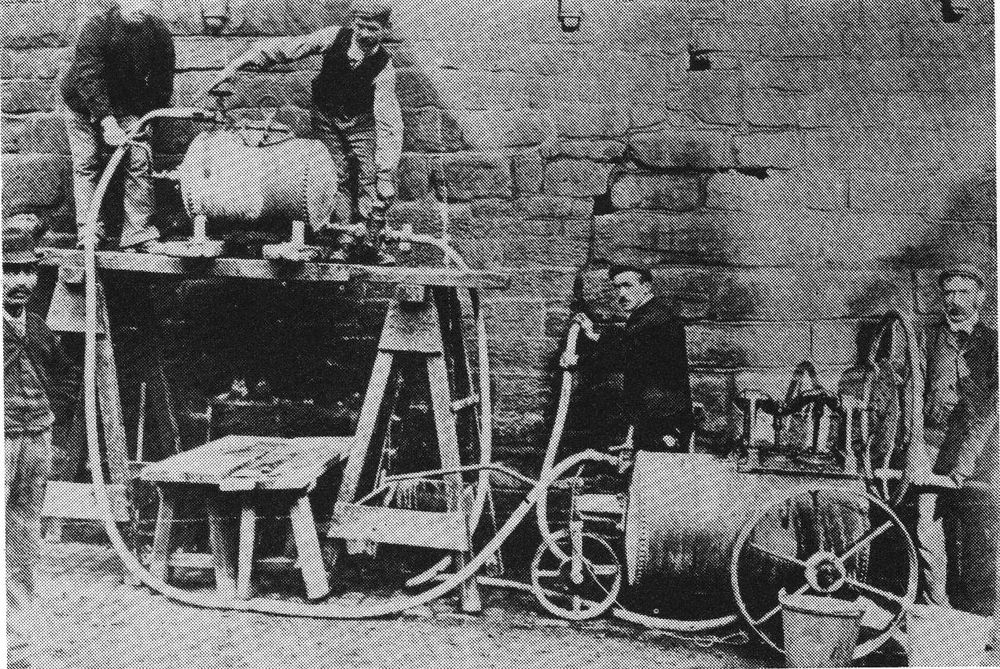
The Greathead Grouting Machine for pumping air to the diver working underwater.

Workers prepare bags of concrete which William Walker will lay under the foundation of the Cathedral.
To celebrate the completion of the work, a thanksgiving service, led by the Archbishop of Canterbury, was held on 15 July 1912, and Walker was presented with a silver rose bowl by King George V.
A humble man, who cycled home 150 miles to Croydon and back, each weekend to see his family, Walker said after receiving the recognition: “It made me feel uncomfortable to be spoken of in the pulpit before that host of people, but I daresay they didn’t know I was the man His Grace was talking about.”
Later, Walker was conferred the Royal Victorian Order (MVO).
William Walker died tragically in 1918, after contracting the Spanish Flu.
In 1964, a statuette in Walker's honor was commissioned. But when the statuette was unveiled, it was found to be that of Francis Fox, the engineer, in a diving suit. Apparently, somebody had handed the sculptor the wrong photograph to work from. The error wasn’t corrected until 2001, when a new statue was installed.

A bust of William Walker on the grounds of the Winchester Cathedral. Photo: Matt Brown/Flickr
References:
# William Walker: The Diver Who Saved The Cathedral, winchester-cathedral.org.uk
# David Farthing, Winchester Cathedral: Safe, Sound, and Secure, winchester-cathedral.org.uk
# Stephen Stafford, Saving the Cathedral, BBC
# David Newnham, Statuesque mistake, TES
# Wikipedia



Interesting article! and thank you. But no one prays TO the hardworking gentleman. They pray FOR him. This is not a trivial distinction.
ReplyDelete